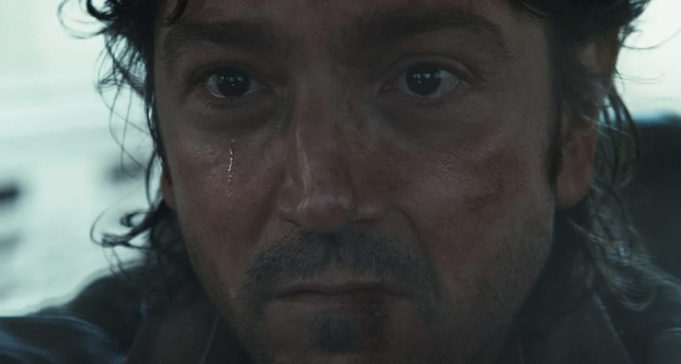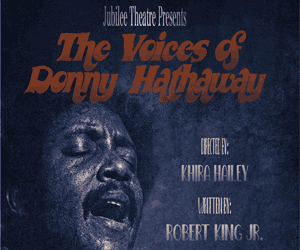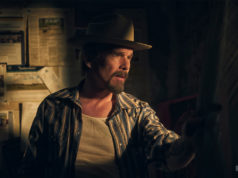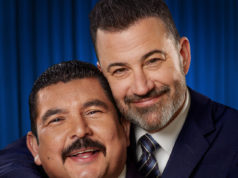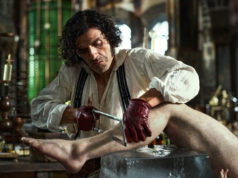A meme derived from a 2009 political cartoon always comes to mind when I see a new Star Wars project. Farmer Mickey Mouse, with an armful of buckets, gleefully strides toward an emaciated and fearful-looking milk cow wearing a Star Wars sign around its neck. Mickey says, “Good morning, Sunshine!” The point is that Disney has milked Star Wars dry. Looking at the slate of TV shows and middling movies, this is not far from the truth. There are highlights among the wreckage, though. Some of the newer films have their moments, and everyone wants to watch Pedro Pascal escort The Child through the universe. I also will take Ewan MacGregor’s Obi Wan Kenobi anyday, but it’s been otherwise disappointing.
Enter: Andor. The series, created by Tony Gilroy, follows Cassian Andor (Diego Luna), the ill-fated sidekick of Felicity Jones’ protagonist from the 2016 film Rogue One: A Star Wars Story. Andor sets out to answer the burning question no one ever cared to ask: How did Cassian Andor become a rebel spy? There is much more going on with the show, but at its heart, this is the story. I could say it’s about how a fascist empire takes over the galaxy, but that has been addressed in every single movie or show to sprout from this IP. One could also argue this is a street-level look at the effect the evil Empire’s actions have on regular people and side characters. In that case, let me point you to Star Wars Rebels.
I realize my bewilderment with this series isn’t broadly shared. Both Season 1 and now Season 2 have been met with much critical acclaim. The show has been hailed as “Star Wars for adults” or a “masterpiece” by various media outlets. But is it? What is at stake for a character we know to be dead already? One that I might point out wasn’t even the lead in the film he originally appeared in. It’s easy to see why so many people jumped on the bandwagon in Season 1. It filled the gulf in mediocre content lingering under the Star Wars tab of Disney’s streaming service. It’s also not a fluke that so many are drawn to it. It’s very well executed. The show is shot well, the cast is excellent, and the overall production is outstanding. Compare it to the recent Star War’s show The Acolyte, and it’s practically the second coming of Christ on every level.
Like Rogue One, it strikes a somber tone, and there is clearly an audience for this type of show in the Star Wars space. After seeing the constant hype, I gave in and watched Season 1. Though I did not care for the first half (it was overly slow and meandered for no good reason), the series crescendos to a satisfying close. The last several episodes were well done and riveting and left me ready for this final season. It’s easy to forgive a show that takes its time world building on the outset if it finally pays off. After all, The Wire is one of my favorite TV shows of all time. I also love White Lotus (maybe not Season 3 as much), The Leftovers, and any other show bold enough to try something new and take its time. These slow burners are sometimes difficult and frustrating, but the good ones are worth the time invested. Andor Season 1 met that criterion, but Season 2 has decided to move sideways instead of forward and is more interested in tone than it is in content and conflict. It prefers to tell and not show, and as it turns out, showrunner Gilroy is just another Mickey Mouse with a milk pail.
Season 1 demonstrates the effects of the Empire on everyday life in the galaxy, and Andor gets caught up in the turmoil. When it’s at its best, it is working to show how someone can get radicalized. At the end of the first season, he has just officially joined the rebellion and seems to understand what this means. Season 2 then should be a race to bridge the gap between him joining the rebels and the mission that takes place in Rogue One. But nine episodes in, and he is still on the fence about his commitment. He spends the majority of Season 2 brooding and taking little to no action. Imagine Hamlet in space.
It seems absurd that three quarters of the final season could go by with no arc for Andor’s character. How could this be? For one, there was a three episode-long wedding that achieved nothing more than having to deal with a character’s change of allegiance. That is, unless you are really into every minute aspect of a Chandrilan wedding. Let me demonstrate further. Here are the competing threads a viewer has to hold onto as the episodes progress in Season 2: Mon Mothma (Genevieve O’Reilly) and Perrin Fertha (Alastair Mackenzie) work through a marriage, a three-episode wedding, and galactic politics; Luthen Rael (Stellan Skarsgard) and Kleya Marki (Elizabeth Dulau) build a rebellion and a spy network; Bix Caleen (Adria Arjona) deals with past traumas and is sidelined on Coruscant; Syril Karn ( Kyle Soller) and Dedra Meero (Denise Gough) make their way up the military ladder of the Empire, attend meetings, and deal with a nosey mother-in-law; Major Partagaz (Anton Lessor) and Orson Krennic (Ben Mendelsohn) do evil stuff and scheme to ruin the universe; Vel Sartha (Faye Marsay) and Cinta Kaz (Varda Sedthu) build a rebellion on Ghorman; Saw Gerrera (Forrest Whitaker) and crew act menacing. Confused or bored yet? That is not even an exhaustive look at every side story. Each one of these, aside from Saw Gerrera, gets close to equal time as Andor, the title character.
Herein lies the problem. The series is stalled out by the scope with which it chose to tell this story. I am the first to defend a show that takes its time with a character. Even one whose fate we know. Take Better Call Saul, for example. It’s a masterclass in character and world building and taking its time to get to large events. What those writers understand is that to do this you need to allow the leads to develop over time. They need a large character arc, yes, but they also need smaller stakes each episode that develop their characters over the larger timeline. This never happens for Andor. He plays the same beat in each scene and is the exact same person he was in Season 1, which has left him relatively inactive or at least ineffective this entire season. As I write this, there are three episodes left, and I cannot imagine how they will connect this series to Rogue One without some incongruous time jump, character changes, or a dispatching of the litany of side characters. Episode 9 of Season 1 ends with Andor flying off in a ship as a single tear runs down his welling eyes as he ponders the state of his affairs. What a fitting metaphor for the experience of watching this once-promising show meet the same fate as the emaciated milk cow.
Andor
Starring Diego Luna, Adria Arjona, Stellan Skarsgard, and Genevieve O’Reilly. Created by Tony Gilroy. Directed by Toby Haytnes, Ariel Kleiman, Benjamin Caron, Susanna White, Janus Metz, and Alonso Ruizapalacios. Rated TV-14. Disney+.



